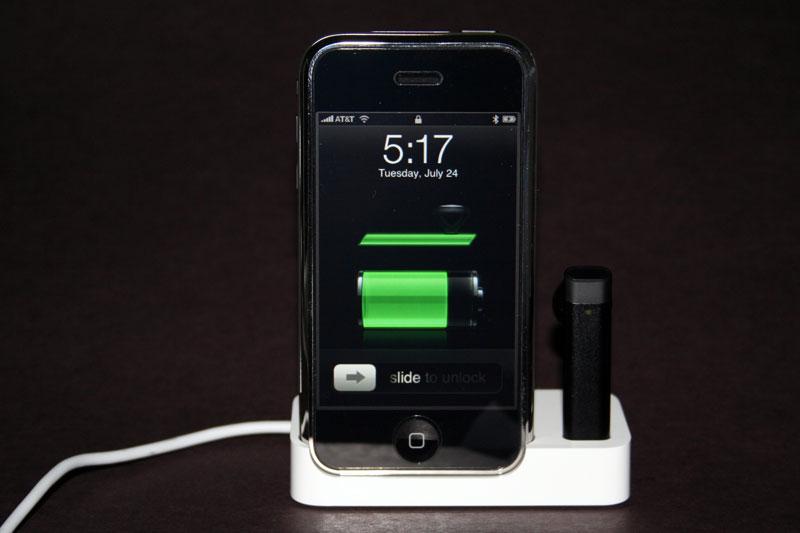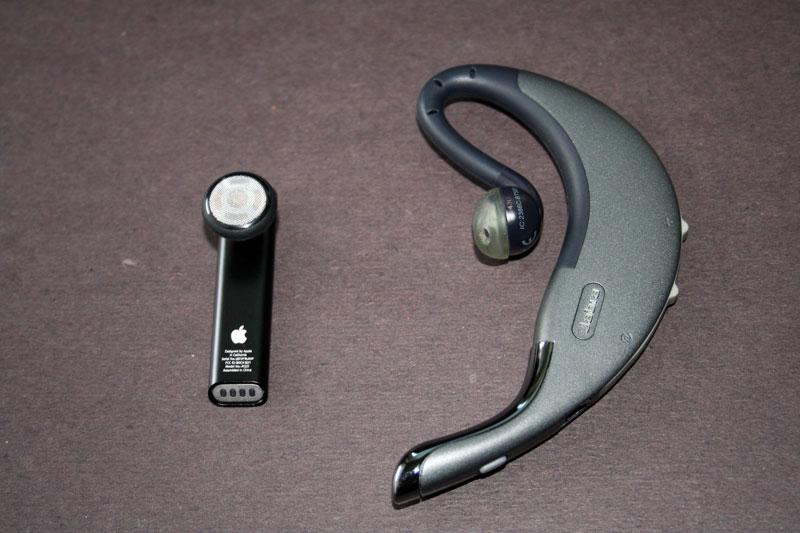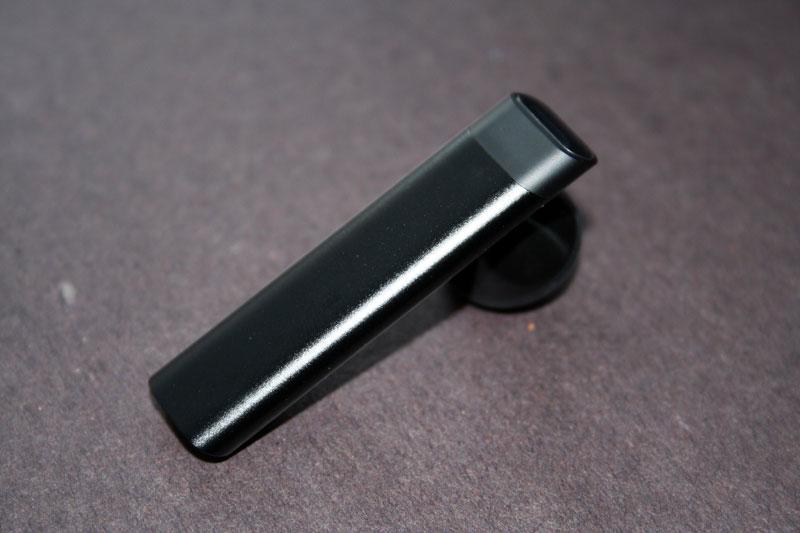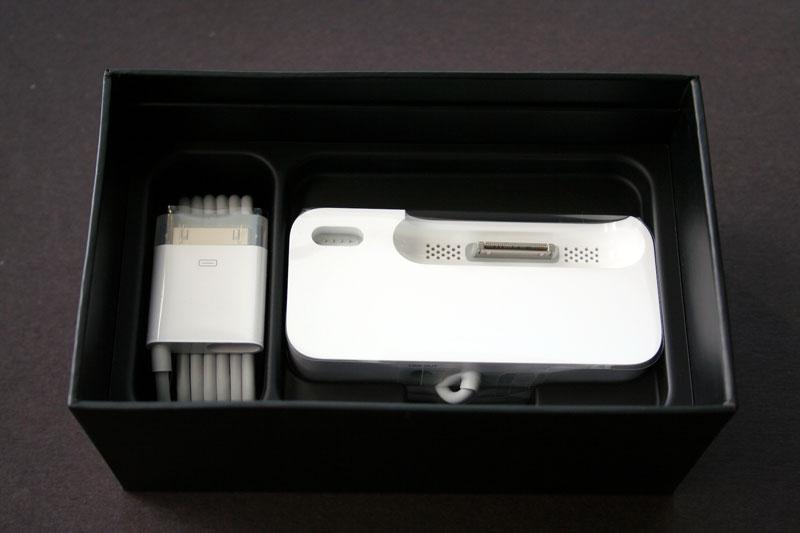- Review: Apple iPhone Bluetooth Headset
- Apple iPhone Bluetooth Headset
- Apple iPhone Bluetooth Headset
- Характеристики Apple iPhone Bluetooth Headset
- Фото дня: эволюция наушников Apple
- Безымянные наушники для iPod
- Внутриканальные «премиальные» наушники для iPod
- Первые наушники для iPhone
- Гарнитура для iPhone в духе AirPods
- «Премиальные» внутриканальные наушники
- Наушники для iPhone с микрофоном
- EarPods
- AirPods
Review: Apple iPhone Bluetooth Headset
Apple iPhone Bluetooth Headset
Apple’s first accessory for the iPhone is its minimalist Bluetooth headset. It’s light, simple, and attractively designed, but also lacks features of comparably priced devices and fails to deliver the full potential of the iPhone.
The headset costs $129, which is near the high end of comparable headsets. It also includes an iPhone dual dock that charges both the headset and the iPhone, and a separate USB docking cable that can be used to charge both from a single USB when traveling. It does not include another wall AC adapter. Apple charges $50 for an iPhone dock and $30 for an extra headset charging USB cable, so having both included in the headset’s box and price makes the price seem fair as a package.
The box is identical to the iPhone’s; it even presents the tiny black adapter in a similar clear plastic tray, as if it were sleeping beauty in a glass coffin waiting for its prince charming to activate it. Apple’s presentation skills are getting so sophisticated that it’s difficult to ever throw the packaging away.
Also inside the box are two iPod style ear piece covers and a thin user guide. The device itself is so simple that the manual is almost unnecessary. Simply plugging it into the dock with the iPhone pairs the two together and charges it up; everything else is managed by its one button on the headset itself:
Push the button to accept or end a call or
Push and hold the button until it beeps to decline a call.
Call Management
With a second call on hold, or when receiving a second call:
Push the button to hold the existing call and take the second call or
Push and hold the button until it beeps to drop the existing call and take the second call.
Power Management
To turn the device on, push and hold the button until three rising tones play and the LED blinks green.
To turn the device off, push and hold the button until three falling tones play and the LED blinks amber.
While on, pushing the button will play a tone and the LED will blink green to indicate that it’s on.
When placed in the dock, the amber LED on the headset flashes while charging, then turns solid green when fully charged. The headset only fits into the dock one way, and snaps into place using a magnetic connection similar to the Mac Book’s MagSafe plug.
The headset promises 5.5 hours of talk time or 72 hours of standby before needing a charge. The provided dock and cable indicate that it needs to be charged about as often as the iPhone. Some headsets offer considerably more battery life, but that also tends to make them larger and heavier. This headset is just 2″ long and as thin as a carpenter’s pencil.
The iPhone’s Match
The headset’s effortlessly simple charging and Bluetooth pairing makes the device well matched for the iPhone. In fact, while Apple includes instructions on how to manually pair it with other phones, it’s obvious that it was designed expressly for iPhone users. Its large desktop dual dock is rather worthless without an iPhone, and its USB cable also cries out for attachment to the phone it was designated to pair with.
Apple doesn’t have to worry about too many consumers wanting its Bluetooth adapter, as there are plenty of cheaper or more broadly featured devices that are widely available. Using it with another phone is a bit like using Apple’s Mighty Mouse with a PC; sure you can, but nobody really has any good reason to do so.
It can be paired with a computer that supports standard Bluetooth headsets using the Hands Free Profile 1.5. The most obvious use outside the iPhone would be as a desktop iChat headset.
Apple’s headset appears to be the black version of the iPod’s white headphones: a subtle indication and perhaps fashion statement that you’re using an Apple product. Unlike the iPod’s inexpensive white earbuds, the Bluetooth headset costs too much to be bundled with every iPhone, making it an extra slightly bit more elitist. Unlike many other headsets, Apple’s looks less like a Star Trek Borg disguise and more like a sophisticated and elegant business tool.
Sound Check
It’s not just looks either. The solid form of the device works in either ear and acts as a directional mic to pick up sound very well; callers remarked that they could hear me as well or better then when talking directly into the iPhone. The earpiece was less ideal, with occasional interference and lower volume than I would prefer, particularly when in a noisy environment. Volume is adjusted from the iPhone; turning up the volume to the max only provided enough sound for a quiet room, and seemed to increase the amount of noise more than the actual signal.
Wireless range depends on a lot of factors, including interference from other radio sources such as a microwave oven, cordless phones, and 2.4 GHz WiFi networking. Apple says the headset has an operating range of «up to 33 feet,» but the headset and the iPhone seemed to do poorly when separated by an obstruction of any kind, even when very close together. Simply putting the iPhone in my back pocket noticeably degraded the signal to the point where it was noisy, and I don’t even have any bionic parts between my ear and my pelvis.
At less than a quarter of an ounce, the nearly weightless headset is at least as comfortable to wear as other earbud headphones, without the tugging wires. It seemed to prefer to occasionally rotate downward so that the mouth piece was pointed at my shoulder rather than my mouth, but it was virtually impossible to get it to fall out of my ear without physically bumping it.
Missing Features
Despite its minimal and sophisticated flat black appearance, Apple’s headset doesn’t do everything other headsets can. Many offer some sort of call redial feature, and some include fancy noise filtering features and a longer battery life. Apart from switching between calls, it doesn’t offer any way to merge calls; any special call handling requires keeping the iPhone out and available. The adapter also doesn’t add any new features to the iPhone, so there’s no way to perform voice dialing, for example.
The most troubling problem for the Bluetooth adapter is that, while it’s certainly serviceable as a phone headset, it ignores both the iPod and the ‘breakthrough Internet device’ that lurk within the iPhone. There’s no way to listen to music or to live podcasts in Safari over the headset, meaning headset users have to restrict their use of the iPhone to simply being a phone, unless they play the iPhone’s music through its built in speaker or through their vehicle’s audio system. Otherwise, listening to music requires putting in earbuds and taking the headset out.
That makes the biggest consideration for potential buyers whether they feel wireless headset operation trumps listening to music. Ideally, Apple will release A2DP Bluetooth support for the iPhone and offer a stereo Bluetooth headset to match, delivering the best of both worlds. Until then, users will have to decide whether the iPhone’s included earbuds — with integrated mic and call accept button — really need to be replaced with a Bluetooth headset.
The Wrap Up
Apple’s Bluetooth Adapter is a well designed product that performs suitably as intended, but doesn’t trade off any simplicity for some of the features in other Bluetooth headsets. Sound quality is very good for the remote caller but only fair to good for the user. Users attracted to Apple’s attractive, minimalist, and easy to use designs shouldn’t be disappointed, but it offers no real surprises in terms of features.
Rating: 3 of 5
- Elegantly slim and very lightweight design.
- Comfortable to wear.
- Includes a dock and extra travel cable.
- Easy to set up and use.
- Limited range and battery life.
- No fancy phone control features or redial.
- No iPhone audio support apart from phone calls.
- No voice dialing support.
For those interested, AppleInsider previously published an in-depth review of the Apple iPhone itself. AppleInsider also published a comparison review of the iPhone from the eyes of a former Blackberry 8700 user.
Apple iPhone Bluetooth Headset
Перед приобретением Apple iPhone Bluetooth Headset по самой низкой цене, изучите характеристики, видео обзоры, плюсы и минусы модели, отзывы покупателей.
Характеристики Apple iPhone Bluetooth Headset
*
| Версия Bluetooth | 2.0 |
| Размеры (ШхВхТ) | 50.1×12.3×5 мм |
| Профиль | Handsfree |
| Вес | 6.5 г |
| Дальность действия | 10 м |
| Тип | моно |
Питание *
| Время работы в режиме разговора / ожидания | 5.50 / 72 ч |
| Тип аккумулятора | Li-Ion |
| Время зарядки | 1.5 ч |
Функции *
| Ожидание/удержание вызова | есть |
| Повтор последнего номера | есть |
| Дополнительные функции | автоматическое парное соединение, индикатор состояния |
| Голосовой набор | есть |
| Ответить/закончить разговор | есть |
Дополнительные возможности *
| Комплектация | гарнитура, зарядное устройство, инструкция |
| Дисплей | нет |
| Сменные панели | нет |
* Точные параметры уточняйте на сайте продавца.
Достоинства: Удобный, стильный, качество звука отменное
Недостатки: Через полгода динамик садится, так что еле слышно, хотя звонящие слышат прекрасно. Я Apple iPhone Bluetooth Headset уже использовал три штуки, результат такой-же.
Фото дня: эволюция наушников Apple
Поступившие в продажу 30 октября AirPods Pro — далеко не первые наушники Apple. Не все знают, но свои первые наушники компания выпустила в далеком 2001 году. Они, разумеется, были проводными и, что удивительно, куда более компактными. Все другие классические наушники Apple запечатлены на фото в этой публикации.
Безымянные наушники для iPod
Первые наушники Apple не имели собственного названия. Они поставлялись с оригинальной моделью плеера iPod, вышедшей 23 октября 2001 года. Наушники дважды обновлялись, так и оставаясь при этом безымянными.
Первые наушники Apple для iPod (2001)
Внутриканальные «премиальные» наушники для iPod
Затем в 2004 году Apple выпустила первые наушники с названием. Это были внутриканальные наушники iPod In-Ear Headphones. Они продвигались как модель с улучшенным звучанием, но большей ценой. Продажи модели прекратились в 2008 году.
iPod In-Ear Headphones (2004)
Первые наушники для iPhone
iPhone Stereo Headset — наушники Apple образца 2007 года, которые поставлялись с первыми смартфонами компании: iPhone и iPhone 3G. Наушники стали первыми с пультом управления, через который можно было управлять музыкой и использовать некоторые функции iPhone, например, делать снимки через приложение «Камера». Оригинальные наушники для iPhone оказались неудачными, на них было много жалоб от пользователей. С запуском iPhone 3GS компания Apple несколько улучшила наушники.
iPhone Stereo Headset (2007)
Гарнитура для iPhone в духе AirPods
Также в 2007 году Apple выпустила необычную Bluetooth-гарнитуру для iPhone — iPhone Bluetooth Headset. Напоминающая AirPods новинка не нашла спроса у пользователей, даже после того, как Apple снизила ее цену до $99. Продажи модели были прекращены в 2009 году.
iPhone Bluetooth Headset (2007) в сравнении с AirPods
«Премиальные» внутриканальные наушники
В 2008 году Apple вновь попыталась продать клиентам внутриканальные наушники. Модель с названием Apple In-Ear Headphones представляла собой оригинальные наушники для iPhone, но с внутриканальными вкладышами. Apple продвигала наушники как премиальные, с улучшенным звучанием, но в итоге прекратила их продажи в 2012 году.
Apple In-Ear Headphones (2008)
Наушники для iPhone с микрофоном
В 2009 году Apple укомплектовала iPhone 3GS новыми наушниками — Apple Earphones with Remote and Mic. Они отличались от предыдущей модели наличием микрофона и новыми кнопками на пульте управления для регулировки громкости. Эта модель также поставлялась с iPhone 4 и iPhone 4S.
Apple Earphones with Remote and Mic (2009)
EarPods
В 2012 году Apple выполнила полный редизайн наушников. На смену моделям с длинными неприятными названиями пришли EarPods. Впервые наушники были поставлены в комплектации с iPhone 5. С тех пор каждый новый iPhone и iPod touch, а также некоторые модели iPad комплектовались этими наушниками. В 2016 году EarPods были обновлены. Вместо 3,5-миллиметрового коннектора в них стал использоваться коннектор Lightning.
AirPods
В 2016 году на презентации iPhone 7 компания Apple совершила настоящую революцию. Она представила AirPods — полностью беспроводные наушники, напичканные самыми различными датчиками. AirPods сделали Apple лидером рынка беспроводных наушников за считанные недели. Весной 2019 года Apple выпустила AirPods второго поколения с увеличенным временем автономной работы и зарядным кейсом с поддержкой беспроводной зарядки.














